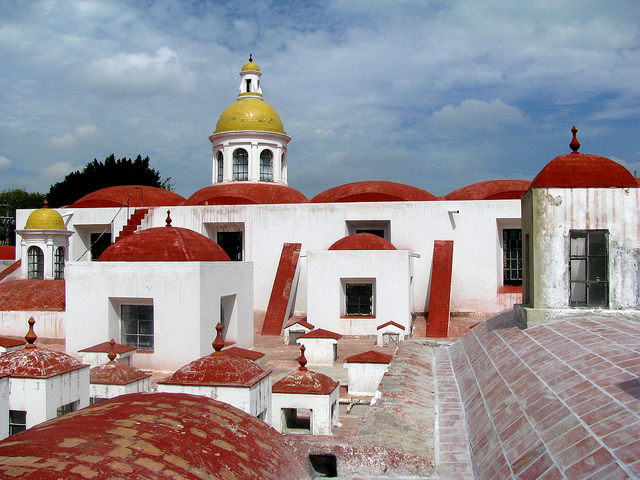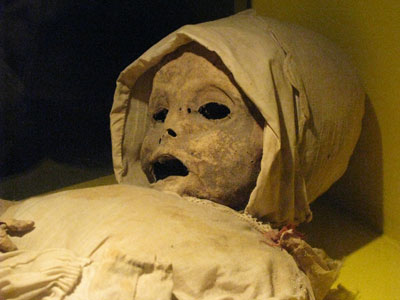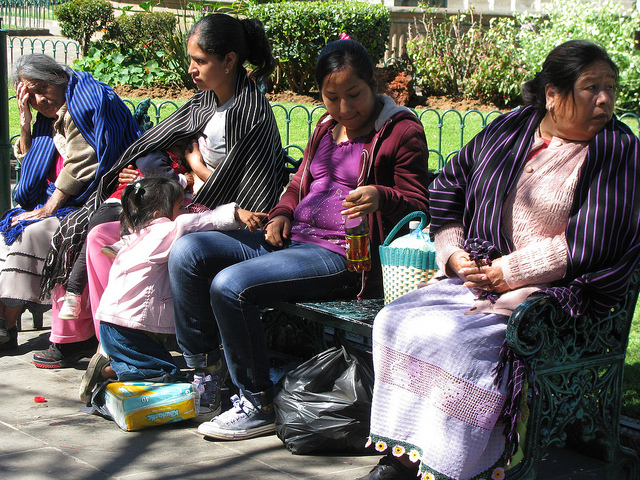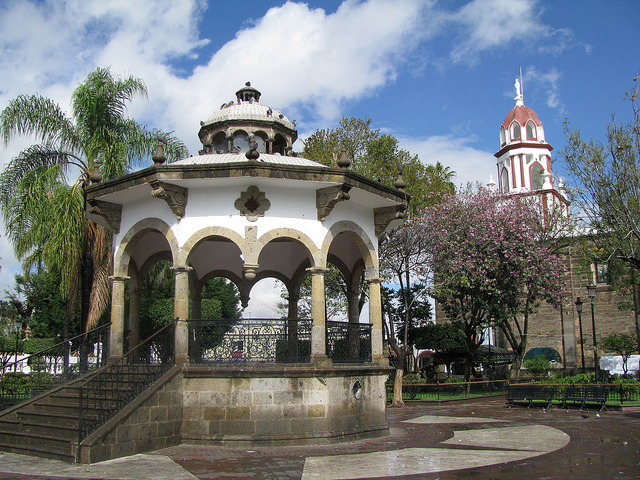After an interesting excursion to downtown Guadalajara yesterday, I had needed a good night’s sleep to rest up for another busy day. This Tuesday morning I got up early and walked the few steps to my language school, the Guadalajara Language Center, where I would be taking Spanish language classes all this week from 9 to 11 am. Once there, I started using one of the free computers and checked my emails and chatted with some of the other students.
Punctually at 9 am my language class started and our teacher Miguel began to take us through some translation exercises – a really useful endeavour that made me realize how far I am still away from speaking proper Spanish. In addition to my other two colleagues whom I had already met yesterday, today we were joined by an additional student, Craig – who also called himself “Gregorio” – a young former financial analyst from the U.S. who had become frustrated with his career and made a drastic change to his life.

The gorgeous main square of Tlaquepaque, two minutes from my language school
Craig was now a Christian missionary, and when we asked him how that works, he explained that he lives with friends, makes no money and focuses on communicating the message of Christ. Somehow he manages to survive in today’s world without the constraints of a job or even the use of money. I would have liked to ask him many more questions about his new lifestyle but we had to get back to the business of studying Spanish. But this is just one example of the interesting people that you meet when you travel and expose yourself to new environments.

El Parián – one of Tlaquepaque’s most famous sights
At 11 am my classes were finished and I started chatting with some other language students. I ended up meeting four women in their late 50s or early 60s, all from different parts of Canada. They had somehow come together here at the Guadalajara Language Center to study Spanish and to explore Mexican culture. We had a really lovely chat, and the stories of these women were quite interesting.

Sculpture in Tlaquepaque
One of these ladies was recently divorced and had set off on a several months long stay in Mexico by herself. Learning Spanish at the Guadalajara Language Center was her first step in acclimatizing herself to this new country. Another lady had just retired and decided to study Spanish for a couple of months while her husband, a university professor who did not like travel much, was staying home in Ottawa.
One of the other women had travelled here from Calgary and had left her husband on the Pacific Coast in Mexico while her friend had joined her from a town outside of Toronto. This woman’s husband had stayed in Texas because he is unable to handle Mexican food, but she came here to study Spanish and enjoy a bit of a Spanish-learning adventure together with her friend. One thing is for sure: these ladies had a real sense of adventure! They invited me to dinner this evening, but since I had a long excursion planned for this afternoon I was not going to be able to make it. We decided that tomorrow would be a better day to get together and enjoy a nice dinner together.

The Cathedral of Tlaquepaque
Wouter Stut, the owner of the Guadalajara Language Center, had arranged for a professional tour guide by the name of José Orozco to come by at 3:30 in the afternoon to take me on a tour of Lake Chapala. Until then I decided to embark on some local discoveries in Tlaquepaque. I strolled into the centre of this Guadalajara neighbourhood, which took just a few minutes from the language school. One of the most important historical buildings of this area is “El Centro Cultural El Refugio”, a former hospital that was conceptualized by local monk Fray Luis Argüello Bernal in 1859.
The expansive historic complex measures more than 10,000 square meters or 107,000 square feet and has been converted into a cultural centre that includes a school of art and dance as well as a variety of exhibition spaces. The hospital was closed in 1979 after a period of abandonment and the Municipality of Tlaquepaque purchased and restored it. Today El Refugio is one of the most important cultural attractions in Tlaquepaque.

One of the towers viewed from a courtyard inside El Centro Cultural El Refugio
I walked into the office of the centre, introduced myself as a travel writer and the manager kindly agreed to send me a guide, a young man named Joel, to explore this fascinating building. The first place Joel was going to take me was the roof of this unusual structure. A local policeman had to unlock a gate so we could access the roof. Once on top of the building I was awed by the size and the beauty of the building: the white structure was crowned by a multitude of red dome-shaped roof sections with small red-roofed square towers that let daylight into the vaulted spaces below. El Refugio features four courtyards, all surrounded by arcaded walkways. The chapel of the complex is capped by a golden dome that forms the focal point of this interesting roof structure.

The fascinating roof structure of El Refugio
The south side of the roof holds a terrace that provides a phenomenal view over the rooftops of Tlaquepaque. The church spires of the Parroquia de San Pedro and the Iglesia de Nuestra Señora de la Soledad can be perfectly viewed from this spot. Joel told me that during the coming weekend, El Refugio was hosting the ExpoEnArt, a major decorative arts trade show with more than 200 exhibitors from most of Mexico’s 31 states. Unfortunately I was going to miss this interesting exhibition because for this coming weekend I had already planned an out-of-town excursion to the historic city of Morelia. But it sounded like a fabulous event to go to.

On the roof of El Refugio
As we were walking on the roof, Joel pointed out several artists’ workshops in the neighbourhood, from pottery to painting, glass-blowing and jewellery-making, by all different artisans who live and work in this neighbourhood. Tlaquepaque is well known for being an artists’ village and the main street is full of galleries and art shops.

Archway inside El Refugio
From the rooftop we peered down into the patio that is surrounded by the Art School where painting and dance are taught. In the Patio del Aguacate (the Avocado Patio) there was a life-size nativity scene that had been located here since Christmas. Joel also explained that a tunnel used to connect this building with a chapel and cemetery some distance away which provided refuge to Christians during the Cristero War that was waged against Christians between 1926 and 1929. Catholics were persecuted at that time and many of them died.

Interesting roof structure at El Refugio
We came down from the roof and went inside the building. From ground level I could now see the inside of the small square towers on the roof that let in daylight. Next to the School of Arts is an entranceway that features two brilliant murals by local artist Pilar Coffeen that illustrate the different activities in the school. A few steps away in the pottery museum, called the Museo Premio Nacional de la Céramica Panteleón Panduro, we also admired the collection of prize-winning pottery that is exhibited on the north side of the building. Amazing pieces of clay art, all created by national pottery prize winners, depict scenes from Mexican history, trees of life and mystical figures.

Prize-winning ceramic art inside El Refugio
My tour with Joel had come to an end but before he left he connected me with Mr. Bernardo, the official historian of El Refugio. He took me to the chapel of the complex and showed me an artistic masterpiece: a huge mural by Camilo Rodriguez in dark brown and grey tones with surrealist features that was completed in 1985. Two brightly coloured murals at the entrance of the chapel were created much more recently and represent images from Spanish colonial and Mexican times. El Centro Cultural is definitely a place for art lovers!

Monumental mural at El Centro Cultural El Refugio
With my personal tour now completed, I walked into the centre of Tlaquepaque which is anchored by a picturesque public square. Just a few steps away is “El Parián”, a square building with a large interior courtyard that is home to 18 restaurants. This was the perfect place for me to relax a bit and have a drink in the shade. The courtyard was relatively quiet around 3 pm, but definitely becomes a hotbed of activity in the evening when all the restaurants are full. A mariachi band was serenading a small group of tourists who were enjoying the Mexican folk songs.

Mariachis are playing for the patrons at El Parián
I did not have much time to rest though since I had to rush back to the Guadalajara Language Center for my next adventure: a guided tour to Lake Chapala!




